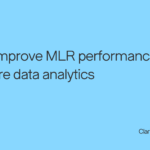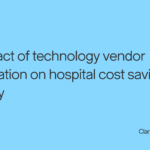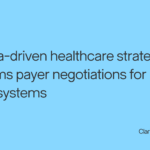Today’s healthcare providers face significant challenges that can impede their ability to deliver consistent, high-quality care. Fragmented and siloed care, inefficiencies and high operational costs, poor patient satisfaction, complicated chronic conditions, challenges to achieving value-based care metrics, a lack of insight into market insights, and inadequate patient follow-up care all present barriers to providing a holistic patient journey and implementing strategic growth opportunities for providers. To address these challenges, providers must gain a –comprehensive understanding of the patient journey. By viewing the entire continuum of care from the patient’s perspective, providers can identify and close gaps in care, improve coordination across services, and make more informed decisions about resource allocation. This approach enhances patient outcomes and positions providers for strategic growth. Healthcare data analytics plays a pivotal role in achieving these objectives. By integrating and analyzing data from various sources, analytics provide the insights needed to make informed, data-driven decisions, ultimately helping providers deliver better care and grow strategically. Fragmented care delivery is a persistent challenge in healthcare. Many providers struggle with disjointed care processes, leading to inconsistent patient experiences and suboptimal outcomes. Patients often navigate through a maze of different specialists, facilities, and services, with little coordination between them. This fragmentation can result in missed diagnoses, delayed treatments, and poorer patient outcomes. Having access to an integrated and unified data analytics platform can help combine data from sources such as electronic medical records (EHR) claims databases, laboratories, and pharmacies to create a comprehensive map of patient journeys and highlight critical touchpoints for improvement. By understanding every touchpoint and transition a patient goes through, providers can identify gaps in care and areas where improved coordination is needed. This comprehensive understanding enables the design of more integrated care pathways that ensure patients receive continuous, coordinated care across different settings. Many healthcare providers face the challenge of inefficient resource utilization. Misaligned staffing, underused equipment, and poor scheduling can lead to operational inefficiencies and increased costs. Without a clear understanding of patient demand, resources are often not allocated where they are needed most. By analyzing patient journeys, providers can gain insights into peak times, high-demand areas, and operational bottlenecks. This understanding allows for better resource allocation, ensuring that staff, equipment, and facilities are used efficiently and effectively. Advanced analytics tools can help providers better predict patient flow and demand trends, allowing providers to optimize their resources based on data-driven insights. Predictive modeling can forecast busy periods and patient needs, enabling better planning and resource allocation, ultimately leading to more efficient operations and improved patient care. Low patient engagement and satisfaction are significant issues for healthcare providers. When patients feel disconnected from their care or dissatisfied with their experience, it can lead to poor retention rates and negative outcomes. Engaged patients are more likely to follow through with treatment plans, attend follow-up appointments, and maintain a proactive role in their healthcare To address these challenges, a deep understanding of the patient journey allows providers to identify key engagement moments and deliver personalized care that meets patient expectations. By knowing what patients value at different stages of their care, providers can tailor their interactions and services to enhance the patient experience, fostering higher engagement and satisfaction. Furthermore, data analytics can track patient interactions, preferences, and feedback, providing valuable insights into what drives patient engagement. By leveraging this data, providers can create personalized communication strategies and care plans that resonate with patients, improving their satisfaction and loyalty. Managing chronic conditions is a complex and ongoing challenge for healthcare providers. Patients with chronic diseases require continuous monitoring, regular follow-ups, and coordinated care across multiple disciplines. Without a holistic view, providers may struggle to manage these patients effectively, leading to avoidable complications and hospital readmissions. A more complete view of patient journeys is essential for effectively managing chronic conditions. Providers can ensure comprehensive management and timely interventions by tracking the entire care continuum for chronic disease patients. This approach improves patient outcomes and reduces the burden on healthcare systems by preventing exacerbations that lead to hospitalizations. Data analytics can provide a holistic view of the care journey for patients with chronic diseases, offering insight into the entire care continuum. This allows for more comprehensive patient care management and can facilitate proactive care planning and intervention strategies by helping providers identify patterns and trends in chronic disease management. As healthcare shifts towards value-based care models, providers are increasingly required to meet specific quality and efficiency metrics. However, achieving these metrics can be challenging without clearly understanding where improvements are needed. To bridge this gap, thoroughly understanding patient journeys allows providers to focus on improving the quality of care at every stage. This comprehensive approach enables them to meet or exceed value-based care metrics, such as reducing hospital readmissions, improving patient satisfaction scores, and enhancing care coordination. In addition, data analytics can monitor performance on key value-based care metrics in real time, providing feedback that helps providers make informed decisions. By identifying areas for improvement and tracking progress, analytics ensures that providers stay aligned with the requirements of value-based care, ultimately leading to better patient outcomes and financial performance. Providers must continuously adapt to changing patient needs and preferences in a competitive healthcare market. However, without comprehensive market insights, providers may miss opportunities for growth and expansion, leading to stagnation. To address this challenge, understanding patient journeys can offer valuable insights into unmet needs, patient preferences, and emerging trends. By understanding what patients want and need at various stages of their care, providers can make strategic decisions about service expansions, new offerings, and market positioning. Moreover, the role of data analytics in market analysis cannot be overstated. By uncovering trends and patient demographics, analytics helps providers tailor their services to meet evolving market demands. Providers can capitalize on new opportunities and drive growth by staying ahead of these trends. For providers to strategically grow, they must ensure that patient journeys are at the forefront of their plan. Data analytics can address challenges with patient engagement and satisfaction by breaking down silos and mitigating fragmented care by helping to put all the pieces of a patient’s care journey together. Understanding the patient journey is essential for healthcare providers seeking to overcome common challenges and achieve strategic growth. Fragmented care, inefficient resource utilization, low patient engagement, challenges in managing chronic conditions, and difficulties in meeting value-based care metrics are just a few of the pain points that can hinder a provider’s success. By adopting a holistic view of the patient journey, providers can identify and address these issues, leading to better patient outcomes, improved operational efficiency, and enhanced patient satisfaction. The key to unlocking these benefits lies in the effective use of data analytics. Analytics provides the insights needed to map out the entire patient journey, revealing critical touchpoints, patient preferences, and areas for improvement. By leveraging data, providers can make informed, data-driven decisions that optimize care delivery, enhance resource allocation, and align with value-based care models. Ultimately, data analytics empowers providers to deliver more personalized, coordinated care, positioning them for sustainable growth in a competitive healthcare market. Fragmented care delivery and the patient experience
How data analytics on patient journeys enhances resource utilization
Improved patient journeys can boost patient engagement
Understanding patient journeys can help providers manage chronic conditions
Striking the right balance to achieve value-based care metrics
Increase growth through better insight into market needs and opportunities
How data analytics can help
- Author Details





